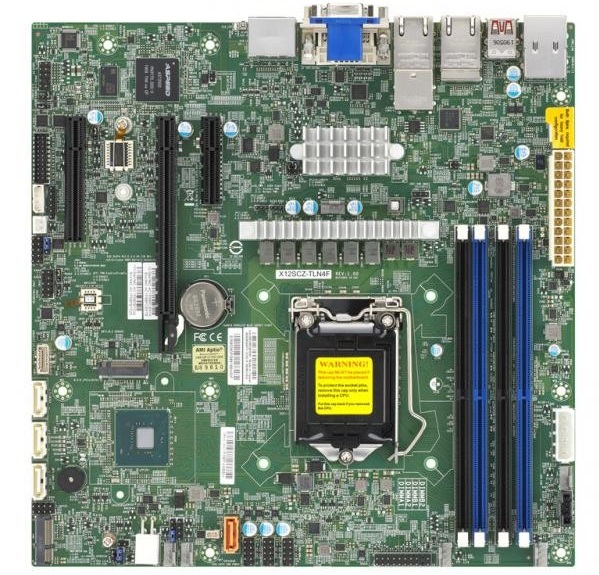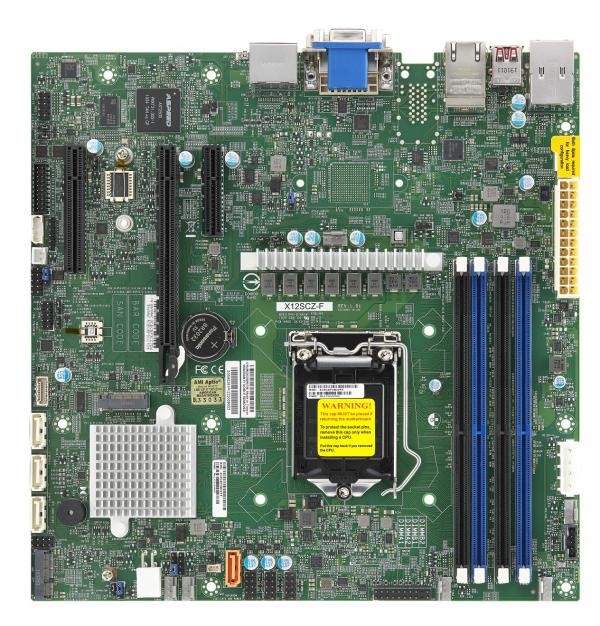The Intel W480 Motherboard Overview: LGA1200 For Xeon W-1200
by Gavin Bonshor on June 24, 2020 9:00 AM ESTSupermicro X12SCZ-TLN4F & X12SCZ-F
For the launch and release of Intel's W480 chipset, Supermicro has prepared a handful of models, each with different configurations to cater to various user needs. Two of Supermicro's W480 models come via the X12SCZ-F and X12SCZ-TLN4F, which share the same core micro-ATX PCB layout, with its green PCB, and black and blue slots. The only difference between both models aside from a few visual differences comes in the controller set. The Supermicro X12SCZ-TLN4F includes dual Intel 10 GbE Ethernet, a single PCIe 3.0 x4 M.2, and four SATA, while the X12SCZ-F opts for dual Gigabit Ethernet.

Supermicro X12SCZ-TLN4F micro-ATX motherboard
Visually, there's not much difference between the Supermicro X12SCZ-F and X12SCZ-TLN4F aside from the heatsink layout. On the latter, there's a heatsink cooling the Intel X550 10 GbE T-Base dual Ethernet controller, while the X12SCZ-F has a heatsink cooling the W480 chipset. This also includes a transposed socket design for installation into rackmount and 1U chassis. Aside from the networking and the onboard audio, both models are identical in specification and design. This includes one full-length PCIe 3.0 x16 slot, with a half-length PCIe 3.0 x4 slot, and a single PCIe 3.0 x1 slot. For storage, there's one PCIe 3.0 x4 M.2 slot, with four SATA ports with support for RAID 0, 1, 5, and 10 arrays. An additional PCIe 3.0 x1 M.2 Key-E slot is also present on both boards.
Focusing on memory support, both the X12SCZ-TLN4F and X12SCZ-F includes four memory slots, with support for up to DDR4-2933 of ECC and non-ECC memory, with a maximum capacity of up to 128 GB. Both models also include an Aspeed AST2500 BMC controller with a D-sub to access the IPMI physically. Supermicro also features memory error detection with the detection of double-bit errors using ECC memory and the correction of single-bit memory errors across all memory types used.

Supermicro X12CZ-F micro-ATX motherboard
As previously mentioned, the only difference between both models is that the X12CZ-TLN4F opts for an Intel X550 10 GbE T-Base dual Ethernet controller, with two additional Ethernet ports with one controlled by an Intel I219LM controller, and another by an Intel I120-AT. The Supermicro X12SCZ-F includes two Ethernet controllers consisting of an Intel I219LM and I210-AT Gigabit controller pairing. Both models include four USB 3.2 G2 Type-A ports, with two DisplayPort video inputs, a D-sub for the boards IPMI, and a serial port. Both models use a Realtek ALC888S HD audio codec for the onboard audio, but Supermicro doesn't specify how this translates to rear panel audio connections.
The Supermicro X12CZ-TLN4F includes superior networking support with dual Gigabit Ethernet ports and a dual 10 GbE T-Base Ethernet, while the X12CZ-F opts for dual Gigabit Ethernet. Both models include a solid professional feature set including an Aspeed AST2500 BMC controller which allows IPMI access physically via a D-sub video output, or via remote access which includes KVM support. Supermicro at present hasn't unveiled pricing on any of its W480 models, as it expects to sell them to system integrators only.










38 Comments
View All Comments
YB1064 - Wednesday, June 24, 2020 - link
Underwhelming at best. Why would anybody go for this over EPYC?Jorgp2 - Wednesday, June 24, 2020 - link
Lolextide - Wednesday, June 24, 2020 - link
This doesn't even compete with Threadripper, much less Epyc. This chipset allows you to use LGA1200 Xeons which are identical to the 10th gen Core series plus ECC support -- which is essentially what you get with regular Ryzen line -- except the regular ryzen line goes to 16 cores and ECC is only "semi official"foobaz - Wednesday, June 24, 2020 - link
The Xeon has one minor advantage over Ryzen - the Xeon does both ECC and integrated graphics. Ryzen APUs can't do ECC, so if you want ECC, you need to pair a Ryzen without integrated graphics with either a discrete GPU or a motherboard with onboard graphics like the X470D4U.PixyMisa - Wednesday, June 24, 2020 - link
For a server though, you want BMC, so you want a motherboard like the X470D4U.And for a workstation, in most cases you want discrete graphics.
abeetz - Sunday, January 23, 2022 - link
For one, the W480 Vision W from Gigabyte includes AMT, as far as I can tell. Some are selling it as a workstation board, and the W-1370 / 1370P CPUs are positioned as workstation processors. But I don't see any downside to using this as a pretty beefy server. It does have a fancy audio section, but that in itself shouldn't disqualify server use. Happy to get anyone else's take on this here. Saying this, of course, because I was able to get a hold of that motherboard + W-1370P CPU, both currently rare, and am considering them as a server for a small business whose network I run.abeetz - Sunday, January 23, 2022 - link
Correction - I meant that some are selling it as a SERVER board...0ldman79 - Wednesday, June 24, 2020 - link
When you're talking servers the dinky GPU doesn't factor in.The price difference between the Intel and AMD line they can more than afford to toss in any motherboard-integrated GPU they can think of.
I'd say 99% of the time the server GPU is only used during initial setup and config. Everything is remote managed.
I even go so far as to disconnect the mouse, keyboard and monitor on almost every server I set up. Keeps the business owner's kids from screwing with it.
The iGPU is not a deciding factor in a server purchase.
eek2121 - Wednesday, June 24, 2020 - link
I don’t know about that. Ryzen chips can do ECC, I actually haven’t looked at whether the APUs have a different memory controller, but all Ryzen chips support ECC. My X570 board let’s me enable it via the BIOS (F20a, AMD CBS menu).Slash3 - Thursday, June 25, 2020 - link
Pro series APUs do support ECC, but non-Pro APUs do not.